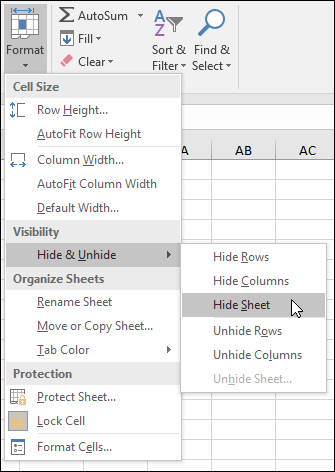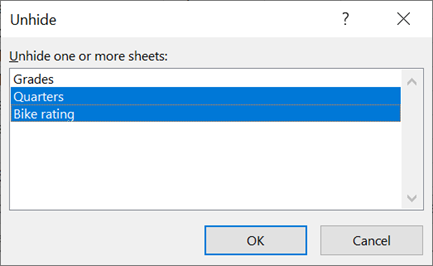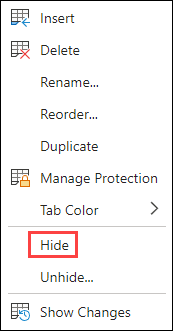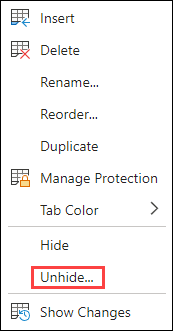- Hide or Unhide worksheets
- Hide or unhide a worksheet
- Hide or unhide a workbook window
- Hide or display workbook windows on the Windows taskbar
- Hide or unhide a worksheet
- Hide or unhide a workbook window
- Hide a worksheet
- Unhide a worksheet
- Need more help?
- Show all windows in the taskbar excel
- Answered by:
- Question
- Answers
- All replies
Hide or Unhide worksheets
You can hide any worksheet to remove it from view. The data in hidden worksheets is not visible, but it can still be referenced from other worksheets and workbooks, and you can easily unhide hidden worksheets as needed.
Right-click the sheet tab you want to hide, or any visible sheet if you want to unhide sheets.
On the menu that appears, do one of the following:
To hide the sheet, select Hide.
To unhide hidden sheets, select them in the Unhide dialog that appears, and then select OK.
Notes: To select multiple sheets do either of these:
Press and hold CTRL, then click the items to select them.
Press and hold SHIFT, then use the up and down arrow keys to adjust your selection.
These steps work for Microsoft 365 subscribers, as do the steps on the tab below that matches your operating system. For perpetual Office versions, see the tabs below for steps supported by your specific version of Excel.
Hide or unhide a worksheet
Note: The screen shots in this article were taken in Excel 2016. If you have a different version your view might be slightly different, but unless otherwise noted, the functionality is the same.
Select the worksheets that you want to hide.
How to select worksheets
Click the sheet tab.
If you don’t see the tab that you want, click the scrolling buttons to the left of the sheet tabs to display the tab, and then click the tab.
Two or more adjacent sheets
Click the tab for the first sheet. Then hold down Shift while you click the tab for the last sheet that you want to select.
Two or more nonadjacent sheets
Click the tab for the first sheet. Then hold down Ctrl while you click the tabs of the other sheets that you want to select.
All sheets in a workbook
Right-click a sheet tab, and then click Select All Sheets on the shortcut menu.
Tip: When multiple worksheets are selected, [Group] appears in the title bar at the top of the worksheet. To cancel a selection of multiple worksheets in a workbook, click any unselected worksheet. If no unselected sheet is visible, right-click the tab of a selected sheet, and then click Ungroup Sheets on the shortcut menu.
On the Home tab, in the Cells group, click Format > Visibility > Hide & Unhide > Hide Sheet.

To unhide worksheets, follow the same steps, but select Unhide. You’ll be presented with a dialog box listing which sheets are hidden, so select the ones you want to unhide.
Note: Worksheets hidden by VBA code have the property xlSheetVeryHidden; the Unhide command will not display those hidden sheets. If you are using a workbook that contains VBA code and you encounter problems with hidden worksheets, contact the workbook owner for more information.
Hide or unhide a workbook window
On the View tab, in the Window group, click Hide or Unhide.
On a Mac, this is under the Window menu in the file menu above the ribbon.

When you Unhide a workbook, select from the list in the Unhide dialog box.
If Unhide is unavailable, the workbook does not contain hidden workbook windows.
When you exit Excel, you will be asked if you want to save changes to the hidden workbook window. Click Yes if you want the workbook window to be the same as you left it (hidden or unhidden), the next time that you open the workbook.
Hide or display workbook windows on the Windows taskbar
Excel 2013 introduced the Single Document Interface, where each workbook opens in its own window.
Click File > Options.
For Excel 2007, click the Microsoft Office Button 
Then click Advanced > Display > clear or select the Show all windows in the Taskbar check box.
Hide or unhide a worksheet
Select the worksheets that you want to hide.
How to select worksheets
Click the sheet tab.
If you don’t see the tab that you want, click the scrolling buttons to the left of the sheet tabs to display the tab, and then click the tab.
Two or more adjacent sheets
Click the tab for the first sheet. Then hold down Shift while you click the tab for the last sheet that you want to select.
Two or more nonadjacent sheets
Click the tab for the first sheet. Then hold down Command while you click the tabs of the other sheets that you want to select.
All sheets in a workbook
Right-click a sheet tab, and then click Select All Sheets on the shortcut menu.
On the Home tab, click Format > under Visibility > Hide & Unhide > Hide Sheet.
To unhide worksheets, follow the same steps, but select Unhide. The Unhide dialog box displays a list of hidden sheets, so select the ones you want to unhide and then select OK.
Hide or unhide a workbook window
Click the Window menu, click Hide or Unhide.
When you Unhide a workbook, select from the list of hidden workbooks in the Unhide dialog box.
If Unhide is unavailable, the workbook does not contain hidden workbook windows.
When you exit Excel, you will be asked if you want to save changes to the hidden workbook window. Click Yes if you want the workbook window to be the same as you left it (hidden or unhidden) the next time that you open the workbook.
Hide a worksheet
Right click on the tab you want to hide.
Unhide a worksheet
Right click on any visible tab.
Select Unhide.
Mark the tabs to unhide.
Need more help?
You can always ask an expert in the Excel Tech Community or get support in the Answers community.
Show all windows in the taskbar excel
This forum has migrated to Microsoft Q&A. Visit Microsoft Q&A to post new questions.
Answered by:
Question
If you like the comfort of being able to close/x out (in MS Word or Excel) one single document and still have the session open you are out of luck! Now you have to X out of the session. In office 2010 you could avoid that by going to File>>Option>>advanced>>Display and uncheck «Show all windows in the taskbar» to get that taken care of — That option is now gone. Now if you open 10 Word or Excel documents you will end up with 10 sessions of Word or Excel (That’s quite taxing on CPU). This is very very very dummm!
If anyone has a work around I’d greatly appreciate a fix
Answers
Based on my research, the MDI Mode (Show all windows in the Taskbar) feature has been fully removed. Referring to the following link:
Then here’s a workaround, set «Always combine, hide labels» in the Taskbar setting, then the documents will show in one icon in the taskbar, then right click the icon, there will show an option «Close all windows». Following the following steps:
- Right click on the task bar
- Select «Properties»
- Select «Taskbar Tab»
- Taskbar Buttons drop down, select «Always combine, hide labels»
- Click «Apply» button
- Click «Ok» button
Jaynet Zhang
TechNet Community Support
All replies
Based on my research, the MDI Mode (Show all windows in the Taskbar) feature has been fully removed. Referring to the following link:
Then here’s a workaround, set «Always combine, hide labels» in the Taskbar setting, then the documents will show in one icon in the taskbar, then right click the icon, there will show an option «Close all windows». Following the following steps:
- Right click on the task bar
- Select «Properties»
- Select «Taskbar Tab»
- Taskbar Buttons drop down, select «Always combine, hide labels»
- Click «Apply» button
- Click «Ok» button
Jaynet Zhang
TechNet Community Support
This solution is no good in my opinion as is applies to all taskbar windows. Plus I think the combine option is the default in windows, so if someone is having this problem then it is someone who has turned this setting off.
If I can’t find a different solution I’m going to be pretty unhappy with this change
If there was a problem — Yo, I’ll solve it
I’m also not happy with this change, the old way worked better for how I work, and I’d at least like the option to go back, like we had in Office 2007 (and I believe 2010 as well). It’s bad enough that Excel insists on showing a taskbar item for each open workbook, but worse, it also shows another taskbar item for the base application?! And closing Excel requires that I close the docs, then close the base app. What a pain. This is a step backwards in UI efficiency.
However.. contrary to Sam’s comment that opening 10 Excel workbooks opens 10 different instances of Excel, that is incorrect. If you inspect the Processes tab in Task Manager, you will see that there is just one instance of Excel running no matter how many workbooks you have open.
I agree with you about them mishandling the taskbar settings.
However, you can close EVERYTHING all at once by holding the shift key while clicking the X in the top right corner of the title bar.
You can add the Close command to your Quick Access Toolbar. That will allow you to close a single document/spreadsheet that’s open in either Word or Excel WITHOUT closing the program itself.
Alternatively, you can close just the active current document with Ctrl-F4 and, even if it’s the only file you have opened, the underlying program remains open.
Hey khun_tilt, I’m glad that you cleared that up for me. Because you understand how everyone works with their PCs, you just know that this change isn’t impactful, right?
This new concept that the taskbar shows open documents, rather than running applications is significant. In Office 2010, you could revert back to ‘normal’, but the lack of this option in 2013, IMO, is a material problem. I’m a software developer, and it’s not uncommon for me to have 8-10+ applications running at one time. Paging through those with alt-tab was bad enough, but now the number of elements that I have to page through (apps plus open docs in Word and Excel ) could be 30+. That is a problem.
If other software vendors (Informatica, Oracle, Hyperion, Adobe, Autodesk) adopt this UI concept, I’m really screwed. But for now, it’s inconsistent, and I don’t like that either.
I don’t think anyone said this is a «world ending disaster», but it does have a real impact on my productivity, and it’s bad software design.








